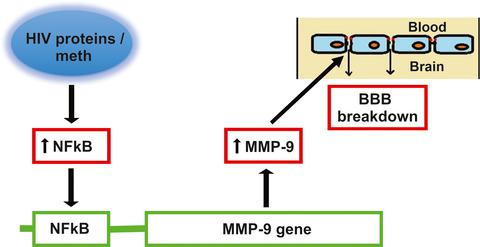当前位置:
X-MOL 学术
›
Eur. J. Nerosci.
›
论文详情
Our official English website, www.x-mol.net, welcomes your feedback! (Note: you will need to create a separate account there.)
Hippocampal blood–brain barrier of methamphetamine self‐administering HIV‐1 transgenic rats
European Journal of Neroscience ( IF 3.4 ) Pub Date : 2020-07-29 , DOI: 10.1111/ejn.14925 Michael Ohene-Nyako 1, 2 , Amanda L Persons 2, 3, 4 , T Celeste Napier 1, 2, 4
European Journal of Neroscience ( IF 3.4 ) Pub Date : 2020-07-29 , DOI: 10.1111/ejn.14925 Michael Ohene-Nyako 1, 2 , Amanda L Persons 2, 3, 4 , T Celeste Napier 1, 2, 4
Affiliation

|
Combined antiretroviral therapy for HIV infection reduces plasma viral load and prolongs life. However, the brain is a viral reservoir, and pathologies such as cognitive decline and blood–brain barrier (BBB) disruption persist. Methamphetamine abuse is prevalent among HIV‐infected individuals. Methamphetamine and HIV toxic proteins can disrupt the BBB, but it is unclear if there exists a common pathway by which HIV proteins and methamphetamine induce BBB damage. Also unknown are the BBB effects imposed by chronic exposure to HIV proteins in the comorbid context of chronic methamphetamine abuse. To evaluate these scenarios, we trained HIV‐1 transgenic (Tg) and non‐Tg rats to self‐administer methamphetamine using a 21‐day paradigm that produced an equivalency dose range at the low end of the amounts self‐titrated by humans. Markers of BBB integrity were measured for the hippocampus, a brain region involved in cognitive function. Outcomes revealed that tight junction proteins, claudin‐5 and occludin, were reduced in Tg rats independent of methamphetamine, and this co‐occurred with increased levels of lipopolysaccharide, albumin (indicating barrier breakdown) and matrix metalloproteinase‐9 (MMP‐9; indicating barrier matrix disruption); reductions in GFAP (indicating astrocytic dysfunction); and microglial activation (indicating inflammation). Evaluations of markers for two signaling pathways that regulate MMP‐9 transcription, NF‐κB and ERK/∆FosB revealed an overall genotype effect for NF‐κB. Methamphetamine did not alter measurements from Tg rats, but in non‐Tg rats, methamphetamine reduced occludin and GFAP, and increased MMP‐9 and NF‐κB. Study outcomes suggest that BBB dysregulation resulting from chronic exposure to HIV‐1 proteins or methamphetamine both involve NF‐κB/MMP‐9.
中文翻译:

甲基苯丙胺自我给药 HIV-1 转基因大鼠的海马血脑屏障
针对 HIV 感染的联合抗逆转录病毒疗法可降低血浆病毒载量并延长寿命。然而,大脑是一个病毒库,认知能力下降和血脑屏障 (BBB) 破坏等病症持续存在。甲基苯丙胺滥用在 HIV 感染者中很普遍。甲基苯丙胺和 HIV 毒性蛋白可以破坏 BBB,但尚不清楚是否存在 HIV 蛋白和甲基苯丙胺诱导 BBB 损伤的共同途径。同样未知的是,在慢性甲基苯丙胺滥用的合并症背景下,长期接触 HIV 蛋白会产生 BBB 效应。为了评估这些情景,我们训练了 HIV-1 转基因 (Tg) 和非 Tg 大鼠使用 21 天范例自我给药甲基苯丙胺,该范例在人类自我滴定量的低端产生等效剂量范围。测量了海马体(一个涉及认知功能的大脑区域)的 BBB 完整性标记。结果显示,Tg 大鼠中紧密连接蛋白 claudin-5 和 occludin 的减少与甲基苯丙胺无关,这与脂多糖、白蛋白(表明屏障破坏)和基质金属蛋白酶-9(MMP-9;表明屏障矩阵破坏);GFAP 减少(表明星形胶质细胞功能障碍);和小胶质细胞激活(表明炎症)。对调节 MMP-9 转录的两个信号通路的标记物 NF-κB 和 ERK/ΔFosB 的评估揭示了 NF-κB 的总体基因型效应。甲基苯丙胺不会改变 Tg 大鼠的测量值,但在非 Tg 大鼠中,甲基苯丙胺会降低 occludin 和 GFAP,并增加 MMP-9 和 NF-κB。
更新日期:2020-07-29
中文翻译:

甲基苯丙胺自我给药 HIV-1 转基因大鼠的海马血脑屏障
针对 HIV 感染的联合抗逆转录病毒疗法可降低血浆病毒载量并延长寿命。然而,大脑是一个病毒库,认知能力下降和血脑屏障 (BBB) 破坏等病症持续存在。甲基苯丙胺滥用在 HIV 感染者中很普遍。甲基苯丙胺和 HIV 毒性蛋白可以破坏 BBB,但尚不清楚是否存在 HIV 蛋白和甲基苯丙胺诱导 BBB 损伤的共同途径。同样未知的是,在慢性甲基苯丙胺滥用的合并症背景下,长期接触 HIV 蛋白会产生 BBB 效应。为了评估这些情景,我们训练了 HIV-1 转基因 (Tg) 和非 Tg 大鼠使用 21 天范例自我给药甲基苯丙胺,该范例在人类自我滴定量的低端产生等效剂量范围。测量了海马体(一个涉及认知功能的大脑区域)的 BBB 完整性标记。结果显示,Tg 大鼠中紧密连接蛋白 claudin-5 和 occludin 的减少与甲基苯丙胺无关,这与脂多糖、白蛋白(表明屏障破坏)和基质金属蛋白酶-9(MMP-9;表明屏障矩阵破坏);GFAP 减少(表明星形胶质细胞功能障碍);和小胶质细胞激活(表明炎症)。对调节 MMP-9 转录的两个信号通路的标记物 NF-κB 和 ERK/ΔFosB 的评估揭示了 NF-κB 的总体基因型效应。甲基苯丙胺不会改变 Tg 大鼠的测量值,但在非 Tg 大鼠中,甲基苯丙胺会降低 occludin 和 GFAP,并增加 MMP-9 和 NF-κB。



























 京公网安备 11010802027423号
京公网安备 11010802027423号